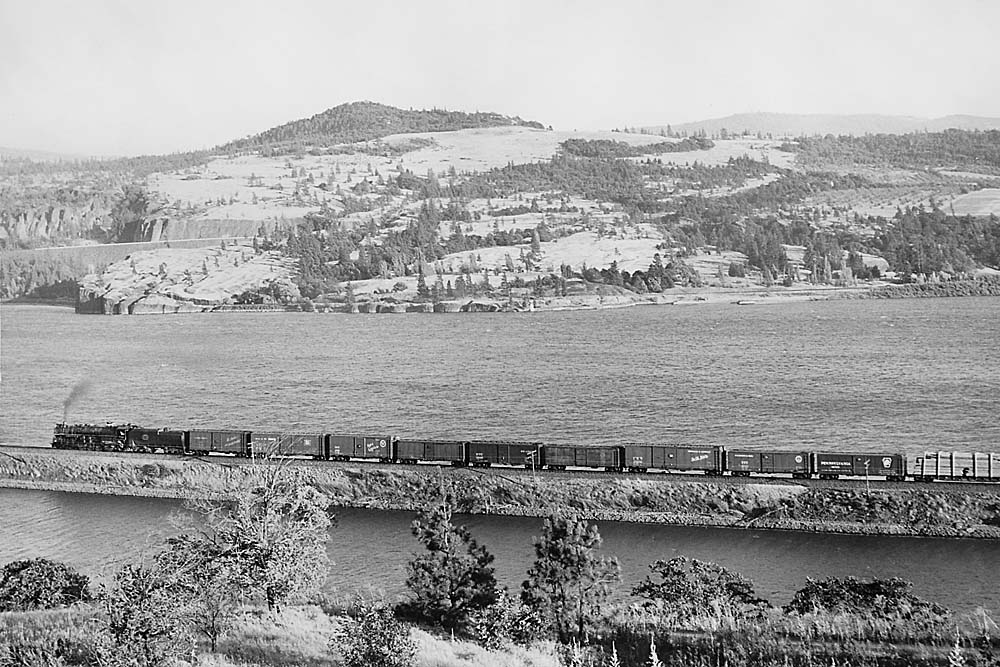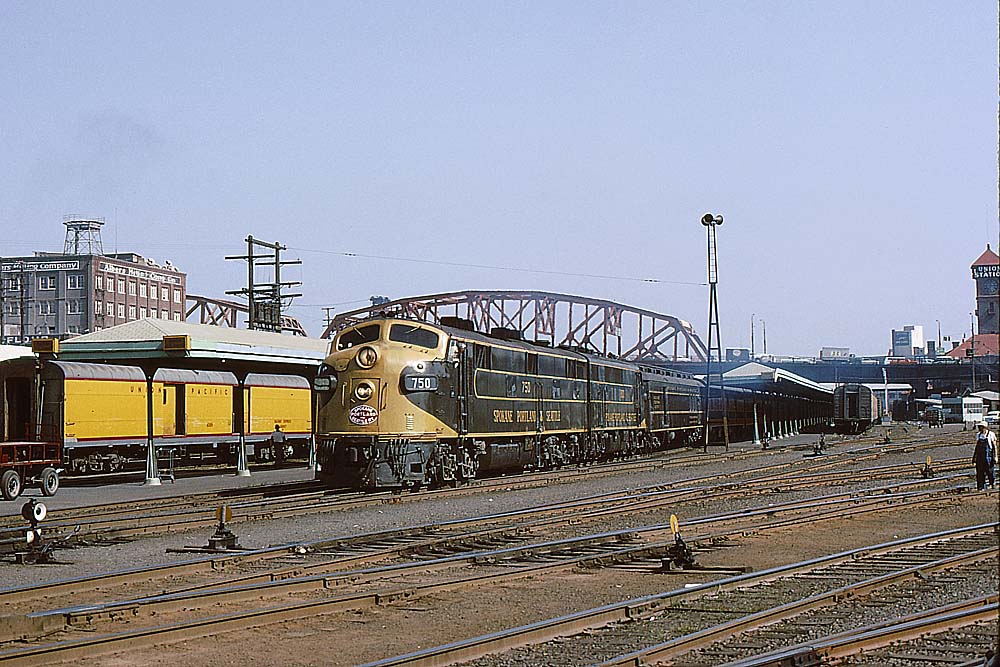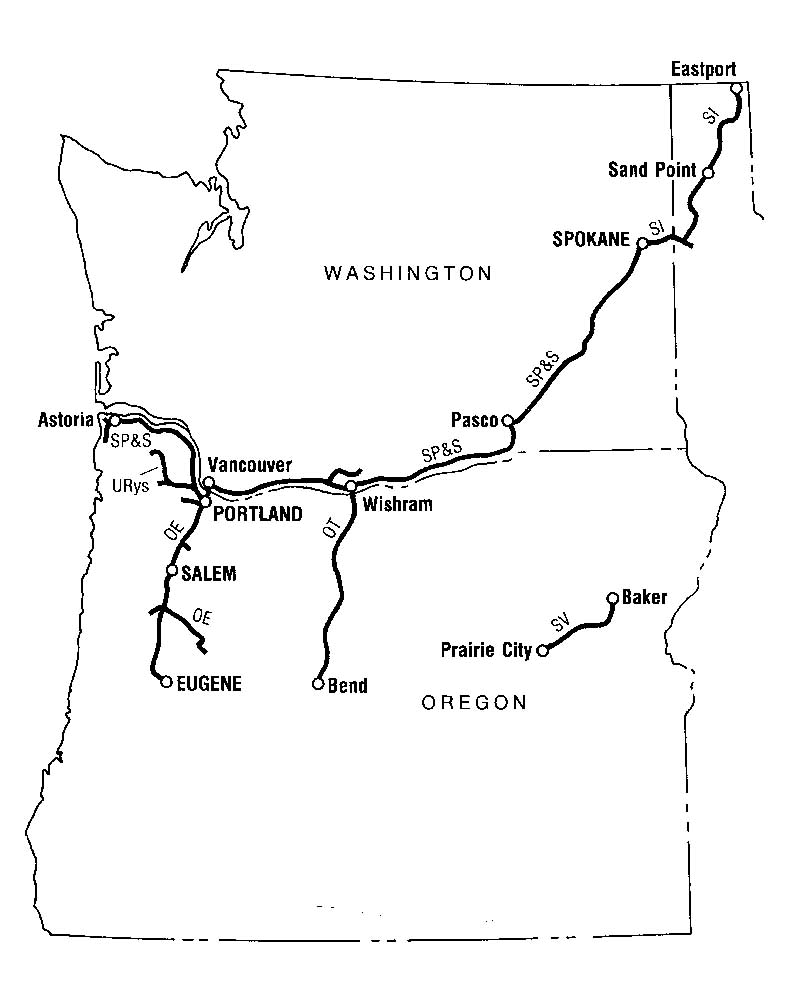The Spokane, Portland and Seattle Railway was the product of sparring during 1905-1909 between “Empire Builder” James J. Hill of the Great Northern and Edward H. Harriman of the Union Pacific and Southern Pacific, by which Hill’s GN, as well as Northern Pacific (which Hill controlled at the time), got much-improved access to Portland, while UP got access to Seattle. The fight continued after Harriman’s death in 1909, with Hill extending SP&S into Oregon to allow GN’s eventual access to California by connection to Western Pacific. GN and NP owned the SP&S 50-50 and in the 1920s considered running it as a joint facility with no separate identity, but decided not to because on-line people viewed it as a local enterprise, to be supported instead of “outsider” lines UP and SP — hence its slogan, “The Northwest’s Own Railway.”

The start was the Portland & Seattle Railroad, incorporated in August 1905 by GN and NP to build jointly owned lines from both Seattle and Spokane to Portland. NP had a Seattle-Portland route but it was inefficient, relying on a carferry across the Columbia River between Kalama, Wash., and Goble, Ore., 39 miles downriver from Portland. UP’s Harriman had 19 percent control of NP stock at the time and was strongly opposed to this, but the NP board outvoted him; Hill had 25 percent of NP’s stock and the support of a majority.
Hill and Harriman, however, worked out a trade in which UP and NP in 1908 jointly built the new line between Tacoma and Portland, including the bridge over the Columbia River at Vancouver, Wash., that eliminated the Kalama ferry. GN was given Seattle-Portland trackage rights over NP and the joint line, while UP built its own line between Tacoma and Seattle. In return, Harriman stopped his efforts to block joint NP-GN Spokane-Portland construction, which was accomplished during 1908-10. The Portland & Seattle was renamed Spokane, Portland and Seattle Railway in 1908. The inclusion of “Seattle” reflected the fact that Seattle-Portland issues were still in negotiation.
The new Spokane, Portland and Seattle Railway “North Bank Road” between Pasco, Wash., and Vancouver was a water-level route involving tunnels and rock-filled causeways. The 229-mile line was built in 29 months beginning in October 1905, crews from east and west meeting at Lyle, Wash., on Feb. 22, 1908. This new line included 9 miles of pre-existing UP-controlled road that UP was using as a blocking property but was sold to SP&S. At the Pasco end, SP&S construction began in Kennewick, Wash., across NP’s Columbia bridge from Pasco, over which SP&S was given rights and the use of NP’s Pasco station and yard. At the west end, the 10 miles between Vancouver and Portland, including big bridges over the Columbia and Willamette rivers, were the responsibility of SP&S, a holdover of the intended P&S Seattle-Portland joint line.
SP&S, NP, and GN service to Portland commenced Dec. 17, 1908, but SP&S was denied access to the Harriman-controlled Union Station and ran its own facility near its new freighthouse and yard at Hoyt Street. Not until United States Railroad Administration directives of 1918-1920 did SP&S trains begin running into Union Station. Post-USRA agreements in 1920 made operation into Union Station by SP&S, NP, and GN permanent. SP&S freights used NP’s Vancouver yard and SP&S’s Hoyt Street, while GN freights used the UP/SP-controlled Guilds Lake yard, in which GN bought a 25 percent interest. NP freights used, in addition to Vancouver yard, one at Willbridge just west of Guild’s Lake. SP&S freights passed Willbridge and Guilds Lake en route to Hoyt Street.
East of Pasco, NP had wanted SP&S to use its line to Spokane by trackage rights, but Hill felt the NP line had excessive grades and curves and wanted a water-level line following the Snake River. SP&S built the latter and placed it in service between Pasco (Ainsworth Junction) and Marshall, Wash., in May 1909, using NP for the remaining 9 miles into Spokane. An SP&S-GN connector from the main line at Fort Wright Junction to Marshall opened in 1910. All of this, like the North Bank to Vancouver, was expensive construction, with benching into the columnar basalt along the Snake, and tunnels. This SP&S Snake River line had almost no local business, though, and that, plus concerns about the long-term stability of the benching, eventually doomed it. Successor Burlington Northern installed CTC signaling on the parallel former NP and abandoned the old SP&S line in 1987. Today it is owned by the State of Washington, and most of it is a trail.

The “Inside Gateway”
The Oregon Trunk Railway was incorporated in 1905 to build from the confluence of the Deschutes River with the Columbia, south into Oregon timber country and potentially into California. It came under Hill control in 1908, with Harriman promoting a competing project. Hill’s and Harriman’s forces conducted legal and physical blocking maneuvers of each other in the Deschutes Canyon until after Harriman died on Sept. 9, 1909. Agreements with the successor UP management were reached in February and May of 1910 that settled things. OT construction could proceed, with UP given trackage rights on the OT where it desired and OT allowed to cross above UP’s Columbia’s south bank main line where OT would be bridging south into Oregon from Fallbridge, Wash. (now Wishram).
The Wishram bridge was placed in service Jan. 5, 1912, and the OT was completed to Bend, Ore., 152 miles from Wishram, in September 1911. Hill died in 1916, but the idea of reaching California didn’t die with him. In 1926, with Southern Pacific newly occupying part of the route into Klamath Falls, GN decided it was time to act. NP at first agreed to be part of the project of extending to Klamath Falls but backed out, so GN acted alone, opening the 144-mile line on May 1, 1928. This included 75 miles of trackage rights on SP between Chemult and Klamath Falls, which SP granted in 1927 to avoid parallel GN construction.
This route, one of the last in modern-day U.S. railroad expansion, was completed in 1931 when Western Pacific built north from Keddie, Calif., to Bieber and met GN building south from Klamath Falls. SP&S operated GN trains from Spokane and/or Portland to Bend, but GN operated Bend to Bieber as an isolated 235-mile division, headquartered at Klamath Falls. This “Inside Gateway” route saw one or two through freights per day, their makeup supplemented by on-line lumber traffic. There was never any through passenger service but owing to the isolated nature of communities along the Deschutes River, SP&S mixed-train passenger service between Wishram and Bend lasted beyond the 1970 BN merger until Amtrak’s inception.
Oregon juice giant
The Oregon Electric Railway began life as a heavy-duty interurban from Portland south up the Willamette valley via Albany to Eugene, but Hill saw it primarily as a source of lumber freight traffic for SP&S, and it was purchased jointly by NP and GN in 1910, with the stock turned over to Spokane, Portland and Seattle Railway in 1911. OE’s entry to Portland over city streets was not suitable for future heavy freight operations.
Hill in 1909 had purchased another interurban running west from Portland, United Railways, also with ambitions for future lumber traffic, so a route was put together using an OE branch and the United to allow OE freights to reach the Hoyt Street yards from the west, though it was not until street franchises ended in 1941 that this route, with stiff grades, became the exclusive freight route. OE’s passenger business dwindled rapidly in the 1920s with the coming of parallel paved roads, and the last OE passenger train ran in 1933.
With the coming of six OE Alco RS1s in 1945, the SP&S system’s first road diesels, the electrification was discontinued. The long-hoped-for lumber traffic, meantime, had developed slowly, and in 1933 GN and NP had considered letting OE default on its debt and go out of SP&S control, but they decided to hold on. An important step in developing lumber traffic was the 1931 construction of the Santiam branch from Albany to Sweet Home and vicinity (jointly with SP to Lebanon). With this addition to traffic originating in the Eugene area and elsewhere, and with the revival of lumber traffic after the Depression and World War II, daily 100-car freights into Portland became the rule, and in 1969 a west wye was built at the south end of the Willamette bridge, permitting OE trains to originate and terminate in Vancouver versus the cramped Hoyt Street.
Today, although BNSF retains ownership of the OE main line, since 2002 all operations on it have been conducted by Genesee & Wyoming’s Portland & Western, with P&W running in and out of Vancouver. BNSF and UP sold the Santiam branch to short line Albany & Eastern in 1998, which still feeds traffic for BNSF from several important plywood and lumber mills via the P&W.
To the Pacific, almost
The SP&S Astoria branch was rooted in the original 39-mile NP line from Portland to the Kalama ferry at Goble. The eastern three miles of this line between Portland and what became the station of Willbridge were crucial to SP&S’s Portland entry. The rest of the Portland-Goble line became part of SP&S’s Astoria branch when a connecting short line linking Seaside, Astoria, and Goble, opened in 1896, was bought for SP&S in 1906 by Hill, fending off a competing offer by Harriman. From then on, NP continued to own Portland-Goble, though only SP&S operated there.
Hill had visions of Astoria becoming a seaport, but the branch never lived up to its promise. Passenger service, once popular in summer for Portland people going to coastal cabins between Astoria and Seaside, ended in 1952. The line between Camp Clatsop and Seaside was abandoned in 1978 and from Astoria to Camp Clatsop in 1982. In the 1970s an export coal terminal at Astoria was talked about, but never built. In 1997 BNSF sold the Portland-Astoria line to the Portland & Western with underlying land going to the State of Oregon. Except for a tourist trolley in Astoria that uses the track, the line is out of service between United Junction, 10 miles west of Portland, and Astoria. From United Junction to Willbridge it provides P&W with a connection between BNSF in Vancouver and the old Oregon Electric main line, via pieces of former SP&S, SP, and OE lines around the west side of Portland.
The 42-mile Goldendale branch opened as a short line in May 1903 and operated in connection with affiliated river steamers. NP, concerned that the line and its steamers would be used by UP to tap Yakima valley traffic, acquired it and the steamers in February 1905, later selling it to SP&S. Always light on traffic, it was abandoned by BN in 1993.
Terminal arrangements at Spokane, and trains using either the SP&S Snake River line or the parallel NP varied over the years, but after 1922 no NP trains used SP&S. After 1942, SP&S freights, carrying mainly GN traffic east of Pasco, used GN’s Hillyard as their Spokane terminal. Many Spokane industries on NP routed traffic via SP&S rather than NP, so an SP&S crew handled a Scribner turn from NP’s Parkwater (Yardley) terminal to connect with Hillyard freights.
Before World War II, SP&S passenger service between Spokane, Pasco, and Portland mostly was just one through train each connecting with GN and NP, and they handled local stops east of Wishram. After the war there were two trains. During the Depression a single connecting train for NP and GN ran on a schedule not suitable for the day local business, so SP&S established the Columbia River Express. After the war it ran only between Pasco and Portland, and SP&S bought lightweight cars for it, with an NP connection relied on for local SP&S passengers east of Pasco. By 1962, SP&S’s connectors to GN’s Empire Builder and NP’s North Coast Limited were running combined, ditto for GN’s Western Star and NP’s Mainstreeter. The Columbia River Express came off in 1959.
Spokane, Portland and Seattle Railway principal classification yard was at Wishram until 1955 when most work was shifted to Pasco to utilize NP’s new electronic retarder yard there. In 1958 GN agreed that its Inside Gateway cars could also be switched at Pasco, and Wishram’s role was minimized.















Thank you for featuring the SP&S. It doesn’t get enough press.
The Astoria line is still active for about 50 more miles west of United Junction to a refinery near the port of Clatskanie. It also serves other large industries on this line.
SP&S actually owned 4 F7A’s 803-806.
The F3 working with the E7 750 is either 800 or 801. Their other F3 802 was a late model appearing as an early F7.